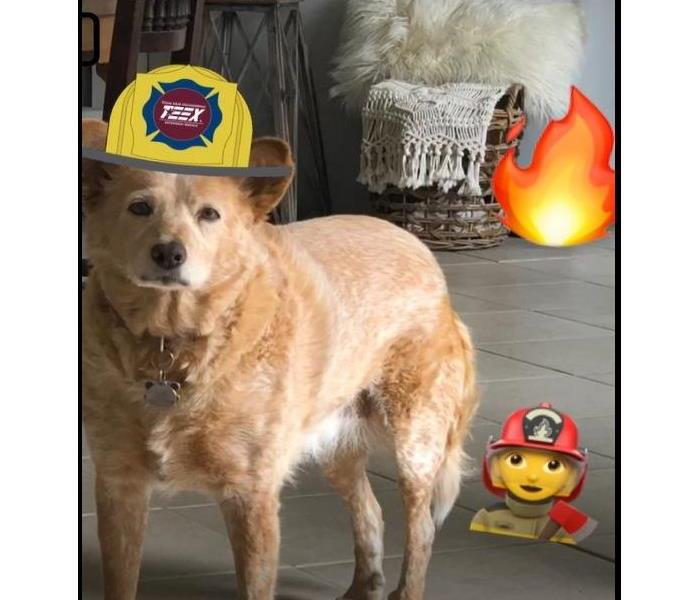National Preparedness Month- Pets and Animals
9/28/2020 (Permalink)
With the threat of fires and earthquakes in the Riverside area its important not to forget our pets. Some families have to leave their pets behind because of how quickly many need to evacuate. This information from Ready.gov will help you prepare your pets.
Get Informed
- Know what disasters could affect your area, which could call for an evacuation and when to shelter in place.
- Keep a NOAA Weather Radio tuned to your local emergency station and monitor TV, radio and follow mobile alert and mobile warnings about severe weather in your area.
- Download the FEMA app and get weather alerts from the National Weather Service for up to five different locations anywhere in the United States.
Make a Plan
Remember, during a disaster what’s good for you is good for your pet, so get them ready today.
If you leave your pets behind, they may be lost, injured or worse. Never leave a pet chained outdoors. Plan options include:
- Create a buddy system in case you’re not home. Ask a trusted neighbor to check on your animals.
- Identify shelters. For public health reasons, many emergency shelters cannot accept pets.
- Find pet friendly hotels along your evacuation route and keep a list in your pet’s emergency kit.
- Locate boarding facilities or animal hospitals near your evacuation shelter.
- Consider an out-of-town friend or relative.
- Locate a veterinarian or animal hospital in the area where you may be seeking temporary shelter in case your pet needs medical care. Add the contact information to your emergency kit.
- Have your pet microchipped and make sure that you not only keep your address and phone number up-to-date, but that you also include contact info for an emergency contact outside of your immediate area.
- Call your local emergency management office, animal shelter or animal control office to get advice and information.
- If you are unable to return to your home right away, you may need to board your pet. Find out where pet boarding facilities are located.
- Most boarding kennels, veterinarians and animal shelters will need your pet's medical records to make sure all vaccinations are current.
- If you have no alternative but to leave your pet at home, there are some precautions you must take, but remember that leaving your pet at home alone can place your animal in great danger!
Tips for Large Animals
If you have large animals such as horses, cattle, sheep, goats or pigs on your property, be sure to prepare before a disaster.
- Ensure all animals have some form of identification.
- Evacuate animals whenever possible. Map out primary and secondary routes in advance.
- Make available vehicles and trailers needed for transporting and supporting each type of animal. Also make available experienced handlers and drivers.
- Ensure destinations have food, water, veterinary care and handling equipment.
- If evacuation is not possible, animal owners must decide whether to move large animals to shelter or turn them outside.
Take extra time to observe livestock, looking for early signs of disease and injury. Severe cold-weather injuries or death primarily occur in the very young or in animals that are already debilitated.
Animals suffering from frostbite don’t exhibit pain. It may be up to two weeks before the injury becomes evident as the damaged tissue starts to slough away. At that point, the injury should be treated as an open wound and a veterinarian should be consulted.
Make sure your livestock has the following to help prevent cold-weather problems:
- Plenty of dry bedding to insulate vulnerable udders, genitals and legs from the frozen ground and frigid winds.
- Windbreaks to keep animals safe from frigid conditions.
- Plenty of food and water.
Build a Kit
Include basic survival items and items to keep your pet happy and comfortable. Start with this list or download Preparing Makes Sense for Pet Owners-Emergency Preparedness Pet Kit List (PDF) to find out exactly what items your pet needs to be Ready.
Your kit should include:
- Food (at least a three day supply in an airtight, waterproof container)
- Water (at least three days of water specifically for your pets)
- Medicines
- Medical records, proof of vaccinations, registration and adoption documents (talk to your veterinarian about microchipping)
- First aid kit (cotton bandage rolls, bandage tape and scissors, antibiotic ointment, flea and tick prevention, latex gloves, isopropyl alcohol, saline solution and a pet first aid reference book)
- Collar or harness with ID tag, rabies tag and a leash
- Crate or pet carrier (a sturdy, safe crate or carrier large enough for your pet to stand, turn around and lie down)
- Sanitation needs (litter box and litter, newspapers, paper towels, plastic trash bags and household chlorine bleach)
- A picture of you and your pet together to prove ownership (add species, breed, age, sex, color and distinguishing characteristics)
- Familiar items (treats, toys and bedding can help reduce stress for your pet)
SERVPRO of West Riverside City urges pet owners to plan for your pets. Include them in your evacuation plan and know where to go and where pets can be taken.
SERVPRO has prepared Ellie our Cattle dog for any emergency!






 24/7 Emergency Service
24/7 Emergency Service
